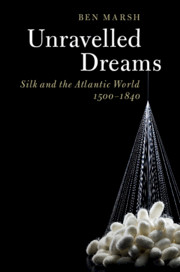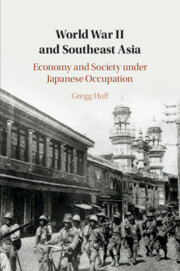Refine search
Actions for selected content:
26946 results in Economic history
Index
-
- Book:
- World War II and Southeast Asia
- Published online:
- 05 October 2020
- Print publication:
- 22 October 2020, pp 491-524
-
- Chapter
- Export citation
Chronology of World War II in the Pacific
-
- Book:
- World War II and Southeast Asia
- Published online:
- 05 October 2020
- Print publication:
- 22 October 2020, pp xiv-xxviii
-
- Chapter
- Export citation
3 - Finance for Japan’s Occupation
-
- Book:
- World War II and Southeast Asia
- Published online:
- 05 October 2020
- Print publication:
- 22 October 2020, pp 84-116
-
- Chapter
- Export citation
Acknowledgements
-
- Book:
- World War II and Southeast Asia
- Published online:
- 05 October 2020
- Print publication:
- 22 October 2020, pp xii-xiii
-
- Chapter
- Export citation
1 - Southeast Asia in the Pacific War
-
- Book:
- World War II and Southeast Asia
- Published online:
- 05 October 2020
- Print publication:
- 22 October 2020, pp 22-47
-
- Chapter
- Export citation
Bibliography
-
- Book:
- World War II and Southeast Asia
- Published online:
- 05 October 2020
- Print publication:
- 22 October 2020, pp 430-490
-
- Chapter
- Export citation

Unravelled Dreams
- Silk and the Atlantic World, 1500–1840
-
- Published online:
- 08 October 2020
- Print publication:
- 23 April 2020

World War II and Southeast Asia
- Economy and Society under Japanese Occupation
-
- Published online:
- 05 October 2020
- Print publication:
- 22 October 2020
Editors’ Note
-
- Journal:
- Business History Review / Volume 94 / Issue 3 / Autumn 2020
- Published online by Cambridge University Press:
- 25 November 2020, p. 481
- Print publication:
- Autumn 2020
-
- Article
-
- You have access
- HTML
- Export citation
Vernacular Industrialism in China: Local Innovation and Translated Technologies in the Making of a Cosmetics Empire, 1900–1940. By Eugenia Lean. New York: Columbia University Press, 2020. 416 pp. Notes, references, index. Cloth, $65.00. ISBN: 978-0-231-19348-1.
-
- Journal:
- Business History Review / Volume 94 / Issue 3 / Autumn 2020
- Published online by Cambridge University Press:
- 25 November 2020, pp. 666-669
- Print publication:
- Autumn 2020
-
- Article
- Export citation
Announcements
-
- Journal:
- Business History Review / Volume 94 / Issue 3 / Autumn 2020
- Published online by Cambridge University Press:
- 25 November 2020, pp. 627-629
- Print publication:
- Autumn 2020
-
- Article
-
- You have access
- HTML
- Export citation
BHR volume 94 issue 3 Cover and Front matter
-
- Journal:
- Business History Review / Volume 94 / Issue 3 / Autumn 2020
- Published online by Cambridge University Press:
- 25 November 2020, pp. f1-f6
- Print publication:
- Autumn 2020
-
- Article
-
- You have access
- Export citation
Global Economic History. Edited by Tirthankar Roy and Giorgio Riello. London: Bloomsbury Academic, 2019. xiv + 370 pp. Tables, figures, references, notes, index. Paper, $54.99. ISBN: 978-1-4725-8843-2.
-
- Journal:
- Business History Review / Volume 94 / Issue 3 / Autumn 2020
- Published online by Cambridge University Press:
- 25 November 2020, pp. 653-655
- Print publication:
- Autumn 2020
-
- Article
- Export citation
British Fire Insurers in Australia, 1860–1920: A Story of Enterprise, Luck, and Resilience
-
- Journal:
- Business History Review / Volume 94 / Issue 3 / Autumn 2020
- Published online by Cambridge University Press:
- 25 November 2020, pp. 535-568
- Print publication:
- Autumn 2020
-
- Article
- Export citation
Animal City: The Domestication of America. By Andrew A. Robichaud. Cambridge, MA: Harvard University Press, 2019. 352 pp. Photographs, maps, notes, index. Cloth, $39.95. ISBN: 9780674919365.
-
- Journal:
- Business History Review / Volume 94 / Issue 3 / Autumn 2020
- Published online by Cambridge University Press:
- 25 November 2020, pp. 658-660
- Print publication:
- Autumn 2020
-
- Article
- Export citation
Investing in the New Republic: Multinational Banks, Political Risk, and the Chinese Revolution of 1911
-
- Journal:
- Business History Review / Volume 94 / Issue 3 / Autumn 2020
- Published online by Cambridge University Press:
- 25 November 2020, pp. 507-534
- Print publication:
- Autumn 2020
-
- Article
- Export citation
Learning Empire: Globalization and the German Quest for World Status, 1875–1919. By Erik Grimmer-Solem. Cambridge, U.K.: Cambridge University Press, 2019. xiv + 654 pp. Maps, photographs, figures, bibliography, index. Cloth, $44.99. ISBN: 978-1-108-48382-7.
-
- Journal:
- Business History Review / Volume 94 / Issue 3 / Autumn 2020
- Published online by Cambridge University Press:
- 25 November 2020, pp. 655-658
- Print publication:
- Autumn 2020
-
- Article
- Export citation
Adapting to Crisis: Accounting Information Systems during the Weimar Hyperinflation
-
- Journal:
- Business History Review / Volume 94 / Issue 3 / Autumn 2020
- Published online by Cambridge University Press:
- 25 November 2020, pp. 593-625
- Print publication:
- Autumn 2020
-
- Article
- Export citation
Whom Fortune Favours: The Bank of Montreal and the Rise of North American Finance, vols. 1 and 2. By Laurence B. Mussio. Montreal & Kingston: McGill-Queen's University Press, 2020. 752 pp. Photographs, figures, tables, bibliography, notes, index. Cloth, $90.00. ISBN: 978-0-2280-0068-6.
-
- Journal:
- Business History Review / Volume 94 / Issue 3 / Autumn 2020
- Published online by Cambridge University Press:
- 25 November 2020, pp. 669-672
- Print publication:
- Autumn 2020
-
- Article
- Export citation
The True Revolution of 1968: Mineral Water Trade and the Early Proliferation of Plastic, 1960s–1970s
- Part of
-
- Journal:
- Business History Review / Volume 94 / Issue 3 / Autumn 2020
- Published online by Cambridge University Press:
- 25 November 2020, pp. 483-505
- Print publication:
- Autumn 2020
-
- Article
-
- You have access
- HTML
- Export citation
